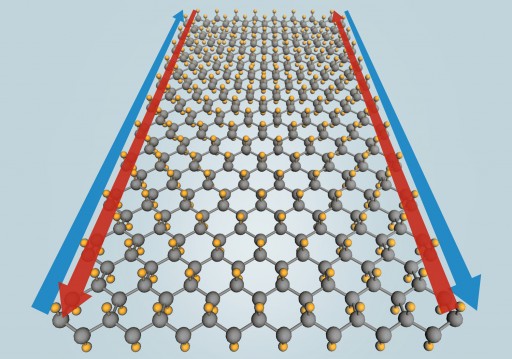Will 2D tin be the next super material for chip interconnects?
New single-layer material could go beyond graphene, conducting
electricity with 100 percent efficiency at room temperature
November 25, 2013
[+]
Move over, graphene. “Stanene” — a single layer of tin
atoms — could be the world’s first material to conduct electricity with
100 percent efficiency at the temperatures that computer chips operate,
according to a team of theoretical physicists led by researchers from
the U.S. Department of Energy’s (DOE) SLAC National Accelerator Laboratory and Stanford University.
Adding
fluorine atoms (yellow) to a single layer of tin atoms (grsy) should
allow a predicted new material, stanene, to conduct electricity
perfectly along its edges (blue and red arrows) at temperatures up to
100 degrees Celsius (212 Fahrenheit) (credit: Yong Xu/Tsinghua
University; Greg Stewart/SLAC)
Stanene — the Latin name for tin (stannum) combined with the suffix used in graphene — could “increase the speed and lower the power needs of future generations of computer chips, if our prediction is confirmed by experiments that are underway in several laboratories around the world,” said team leader Shoucheng Zhang, a physics professor at Stanford and the Stanford Institute for Materials and Energy Sciences (SIMES), a joint institute with SLAC.
For the past decade, Zhang and colleagues have been calculating and predicting the electronic properties of a special class of materials known as topological insulators, which conduct electricity only on their outside edges or surfaces and not through their interiors. When topological insulators are just one atom thick, their edges conduct electricity with 100 percent efficiency. These unusual properties result from complex interactions between the electrons and nuclei of heavy atoms in the materials.
Their calculations indicated that a single layer of tin would be a topological insulator at and above room temperature, and that adding fluorine atoms to the tin would extend its operating range to at least 100 degrees Celsius (212 degrees Fahrenheit).
Ultimately a silicon substitute?
Zhang said the first application for this stanene-fluorine combination could be for interconnects — wiring that connects the many sections of a microprocessor — allowing electrons to flow as freely as cars on a highway. Traffic congestion would still occur at on- and off-ramps made of conventional conductors, he said. But stanene wiring should significantly reduce the power consumption and heat production of microprocessors.
Manufacturing challenges include ensuring that only a single layer of tin is deposited and keeping that single layer intact during high-temperature chip-making processes.
“Eventually, we can imagine stanene being used for many more circuit structures, including replacing silicon in the hearts of transistors,” Zhang said.
Additional contributors included researchers from Tsinghua University in Beijing and the Max Planck Institute for Chemical Physics of Solids in Dresden, Germany. The research was supported by the Mesodynamic Architectures program of the Defense Advanced Research Projects Agency.
Abstract of Physical Review Letters paper
The search for large-gap quantum spin Hall (QSH) insulators and effective approaches to tune QSH states is important for both fundamental and practical interests. Based on first-principles calculations we find two-dimensional tin films are QSH insulators with sizable bulk gaps of 0.3 eV, sufficiently large for practical applications at room temperature. These QSH states can be effectively tuned by chemical functionalization and by external strain. The mechanism for the QSH effect in this system is band inversion at the Γ point, similar to the case of a HgTe quantum well. With surface doping of magnetic elements, the quantum anomalous Hall effect could also be realized.
(¯`*• Global Source and/or more resources at http://goo.gl/zvSV7 │ www.Future-Observatory.blogspot.com and on LinkeIn Group's "Becoming Aware of the Futures" at http://goo.gl/8qKBbK │ @SciCzar │ Point of Contact: www.linkedin.com/in/AndresAgostini
 Washington
Washington